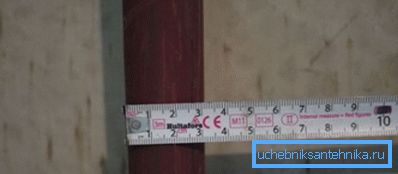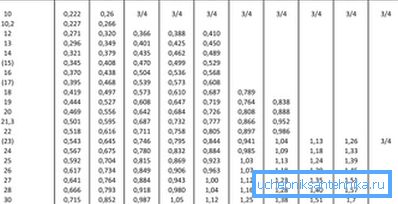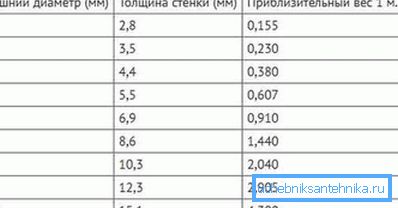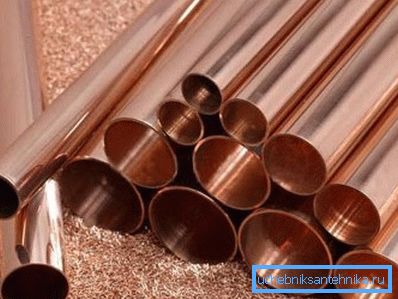Inch tube - conversion to metric calculus
For many people, the metric rather than inch system is more familiar and familiar. Of course, it is not so difficult to convert centimeters to inches, but in the case of pipe size designations, there are a lot of subtleties. Because of this, many novice plumbers openly "float" when choosing, and may make a serious mistake.

What is a pipe inch?
The most important parameter is the inner diameter, although more often when choosing to use the nominal diameter (DN), in other words, the size of the lumen. Bandwidth depends on it.

A typical inch is 25.4 mm, but in the sanitary field this rule, at first glance, does not work. For example, the outer diameter of an inch pipe in mm is 33.5 mm (the value is given for the VGP of the pipeline). An ordinary person in such a situation might think that an error has crept into his calculations.
The thing is that you need to navigate not on the outside, but on the DV, but in this case there is no exact match of 25.4 mm. Thus, the tap-inch corresponds to a DN of 25.0 mm, and as for the DV, the spread can be even greater. The instructions for the construction work hardly mentions the difficulty of converting units of measurement, so you can easily be mistaken.

So, for a light VGP, the Dvn pipe will be 27.9 mm, for an ordinary pipe - 26.4, and for a reinforced pipe - 25.5, the reason for this variation is in the wall thickness. If in such a situation a person will focus on the DN, then, most likely, he will stop at a variant of 26.8 mm, and this size already corresponds? inch, the price of such an error can be significant.
Note! Even a seemingly insignificant downward error greatly affects the capacity and pressure in the system. This may adversely affect its durability.
Sizes of pipes from different materials
Converting inch pipes to metric is especially important when working with different materials. For example, when it is necessary to connect a section of metal and plastic pipeline. In this case, it is necessary to take into account not only Dv, but also Dn. Otherwise, the tightness of the pipe connection will not be achieved.
Steel tubes
When working with them, the production method is also important, and size depends on it. So, the range of sizes of AIV (GOST 3262-75) is in size from 6 to 150 mm (meaning Du).
The thickness of the material varies depending on the version
- in a light VGP pipeline, the thickness varies in the range of 1.8 - 4.0 mm. Accordingly, the inner diameter of the inch pipe will be 25 mm, and the outer one in this example will be 33.5 mm;
- for an ordinary version, the wall may have a thickness of 2.0 - 4.5 mm;
- reinforced version has even greater thickness (2.5 - 5.5 mm).

It is possible to select such types of pipelines as:
- Electrowelded (GOST 10704-91). It differs from VGP by a slightly smaller DN with an equal DN. For example, the dimensions of a half-inch pipe will be equal to: DN - 15, and DN - 20 mm (for VGP this parameter is equal to 21.3 mm);

- Seamless (hot rolled products, GOST 8372-78). In size does not differ from electrowelded, the maximum diameter is 1200 mm.
It can be seen that even with a small diameter, the Dn can be quite different. In the example, even a half-inch pipe in mm gives a difference in Dn of 1.3 mm when comparing AIV and a seamless pipeline.
Plastic piping
When installing plumbing and heating systems with their own hands, polypropylene is often used. The main difficulty in this case is to take into account the different wall thickness depending on the purpose of the system. (See also the article Pipes for plumbing in the apartment: features.)
For example, PN10 can be used for cold water supply, the minimum wall thickness in this case will be 1.9 mm for Dn 20. But PN20 and PN25 can also be used to supply hot water, therefore the wall thickness increases to 3.4 mm for the same size .

When selecting a specific size, it is important not to confuse the Du (the average value of the lumen) and the actual internal size, which differs depending on the width of the wall. It is more convenient to consider this subtlety on a concrete example.
The dimensions of inch pipes in mm look like this: DN - 25, and DN - 32 mm, now we define the value of Dv for each class:
- for PN10 with a wall of 3.0, Dvn will be 26.0 mm;

- but for PN20 Dvn reduced to 21.2 mm.
Note! Such discrepancies in the values of DWs, in principle, are not particularly important if the system is mounted “from scratch” and all elements are purchased immediately. It is much more important to take this into account when it is necessary to dock pipes from different materials, for example, steel and polypropylene.
Metal plastic
In recent years, this material has somewhat lost fans, but, despite this, it is still used. As in the case of polypropylene, you need to focus exclusively on the outer diameter (DN).

For example, the diameter of a half-inch pipe according to manufacturers is 16 mm. In order to determine the internal size, you need to know the wall thickness (in this example, it is 2.0 mm), thus Dwn will be 12.0 mm.
Copper
In the case of copper, everything is quite simple, although the issue with the conversion of values, how much it will be in millimeters, remains popular.
Remember you need a few rules of labeling:
- Inch tube dimensions are used solely to designate exterior dimensions.;

- If the recording format is slightly different, for example, 14/1 or 14/12, then these dimensions are already indicated in millimeters.. The first option denotes the day and width of the wall, and the second - the values of diameters More information about standard sizes can be found in GOST 617-2006.
Note! When joining elements from different materials, it is unlikely that they will be able to accurately pick up their sizes. To ensure a tight connection, as a rule, special adapters are used, taking into account the transition from metric to inch dimensions.
Summarizing
There are allegations that the plumbing inch is a “special” unit of measure, different from the usual 25.4 mm. In fact, this is not the case, and the main confusion arises from the fact that people do not know in what cases the external is indicated, and in which - Dvn.
Does not add clarity and the concept of Du, which is slightly different from the inch equivalent. The examples of the translation of quantities given in the article will make it possible to understand this relatively simple question.
The video in this article shows an example of connecting pipes from different materials.